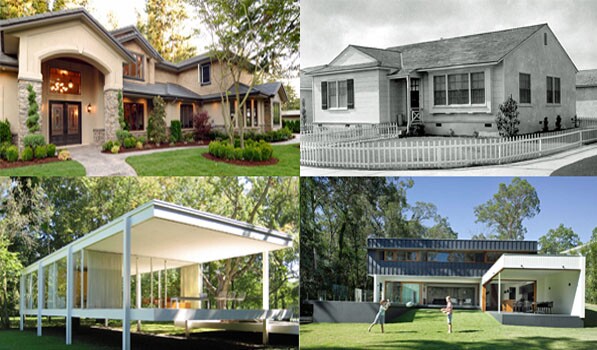Playing House and Making a Home

These pieces have the general title Where We Are. And where we are for at least part of the day is in a house. But being housed isn't the same as being at home. That's more elusive.
I've tried, here and in recent books, to realize what home might be in the houses in which we live. (The French philosopher Gaston Bachelard did this with far greater depth and amplitude in his "Poetics of Space.") The other evening, in a conversation with Lorraine Wild and Diane Keaton at LACMA, I tried again to get from house to home.
Diane Keaton is the author of a new book of contemporary residential architecture called "House". Lorraine Wild (the principle of Green Dragon Office in Los Angeles) collaborated with Diane Keaton and is the book's designer. I wrote some text for it.
After we'd shown images of several of the extraordinary houses in the book, we took questions from the audience. Toward the end, we were asked what our idea of home might be. Diane Keaton, who laughingly called herself a serial renovator, thought that she carried "home" with her as she and her family moved from house to house.
Lorraine Wild noted what she and her husband, an architect, had recently purchased a mid-century house that had been a family's home for many, many years. She was struck, she said, that her neighbors held a kind of farewell party for the house when it was sold. "Home" in this case seemed to be a tradition, although the new owners cannot inhabit a tradition unmixed.
I mentioned that I've lived in the same house since I was born, which drew a few gasps and a few grumbles. "Home" for me is complicated, too.
Earlier in the evening, when I introduced our conversation, I picked up one of the themes of house building and making a home that "House"explores with considerable subtlety:
Diane Keaton remembers drawing a simple box when she was little, adding windows and a door to the box and topping it with a pitched roof. And there was a house. I remember digging in the adobe soil of my suburban backyard, excavating roads, building up house walls, and laying Popsicle sticks over them for a properly modern flat roof. And there was a city of houses.
Our sketching and digging -- the architecture of childhood -- was play. And it was both a joy and an education.
New building technologies and the end of settled cultural authority has now liberated architectural play for grown-ups. Intention, skill, and a willing imagination are needed in both children's play and grown-up architecture.
House is a book that shows architects and their clients playing, sometimes with severe refinement and sometimes with deliberate roughness, but always with sympathy for the structures they grew up with.
It might also be helpful to think of House is a pattern book of forms drawn from American ordinariness, of farm buildings seen in passing on the interstate and isolated factories on the outskirts of town.
Through use and memory, these forms have become familiar. They also can become sympathetic and sheltering. As architecture, these forms speculate on the richness of American vernacular buildings. They acknowledge the durability of those forms in organizing the landscape. And they open a conversation with the lingering past even as these forms speak to the present.
Play always begins with whatever is at hand, turning a cardboard box into a rocket ship or turning the shape of a barn or a factory into a statement about humility and permanence.
It has been my privilege to work on this book with Diane Keaton and Lorraine Wild. What I have learned from them I hope you might learn - to look with wonder and interest at the places we've made for ourselves and at the homes we've fashioned in our play with the much-handled materials of our youth.
When you look with wonder and interest, you see American ordinariness becoming sublime.


